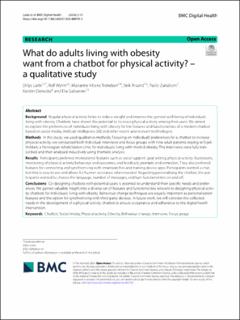| dc.contributor.author | Larbi, Dillys | |
| dc.contributor.author | Wynn, Rolf | |
| dc.contributor.author | Trondsen, Marianne Vibeke | |
| dc.contributor.author | Årsand, Eirik | |
| dc.contributor.author | Zanaboni, Paolo | |
| dc.contributor.author | Denecke, Kerstin | |
| dc.contributor.author | Gabarron, Elia | |
| dc.date.accessioned | 2024-04-02T10:39:49Z | |
| dc.date.available | 2024-04-02T10:39:49Z | |
| dc.date.created | 2024-02-24T22:57:09Z | |
| dc.date.issued | 2024 | |
| dc.identifier.citation | BMC Digital Health. 2024, 2, Artikkel 15. | en_US |
| dc.identifier.issn | 2731-684X | |
| dc.identifier.uri | https://hdl.handle.net/11250/3124432 | |
| dc.description.abstract | Background
Regular physical activity helps to reduce weight and improve the general well-being of individuals living with obesity. Chatbots have shown the potential to increase physical activity among their users. We aimed to explore the preferences of individuals living with obesity for the features and functionalities of a modern chatbot based on social media, Artificial intelligence (AI) and other recent and relevant technologies.
Methods
In this study, we used qualitative methods. Focusing on individuals’ preferences for a chatbot to increase physical activity, we conducted both individual interviews and focus groups with nine adult patients staying at Evjeklinikken, a Norwegian rehabilitation clinic for individuals living with morbid obesity. The interviews were fully transcribed and then analysed inductively using thematic analysis.
Results
Participants preferred motivational features such as social support, goal setting, physical activity illustrations, monitoring of physical activity behaviour and outcomes, and feedback, prompts and reminders. They also preferred features for connecting and synchronising with smartwatches and training device apps. Participants wanted a chatbot that is easy to use and allows for human assistance when needed. Regarding personalising the chatbot, the participants wanted to choose the language, number of messages, and turn functionalities on and off.
Conclusions
Co-designing chatbots with potential users is essential to understand their specific needs and preferences. We gained valuable insight into a diverse set of features and functionalities relevant to designing physical activity chatbots for individuals living with obesity. Behaviour change techniques are equally important as personalisation features and the option for synchronising with third-party devices. In future work, we will consider the collected needs in the development of a physical activity chatbot to ensure acceptance and adherence to the digital health intervention. | en_US |
| dc.language.iso | eng | en_US |
| dc.publisher | BioMed Central (BMC) | en_US |
| dc.rights | Navngivelse 4.0 Internasjonal | * |
| dc.rights.uri | http://creativecommons.org/licenses/by/4.0/deed.no | * |
| dc.subject | chatbot | en_US |
| dc.subject | social media | en_US |
| dc.subject | physical activity | en_US |
| dc.subject | obesity | en_US |
| dc.subject | behaviour change | en_US |
| dc.subject | interview | en_US |
| dc.subject | focus group | en_US |
| dc.title | What do adults living with obesity want from a chatbot for physical activity? – a qualitative study | en_US |
| dc.type | Peer reviewed | en_US |
| dc.type | Journal article | en_US |
| dc.description.version | publishedVersion | en_US |
| dc.rights.holder | © The Author(s) 2024. | en_US |
| dc.subject.nsi | VDP::Teknologi: 500::Informasjons- og kommunikasjonsteknologi: 550 | en_US |
| dc.subject.nsi | VDP::Medisinske Fag: 700::Helsefag: 800 | en_US |
| dc.source.volume | 2 | en_US |
| dc.source.journal | BMC Digital Health | en_US |
| dc.identifier.doi | https://doi.org/10.1186/s44247-024-00070-3 | |
| dc.identifier.cristin | 2249470 | |
| dc.source.articlenumber | 15 | en_US |
| cristin.ispublished | true | |
| cristin.fulltext | original | |
| cristin.qualitycode | 1 | |

